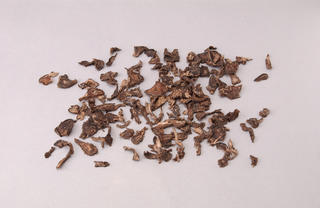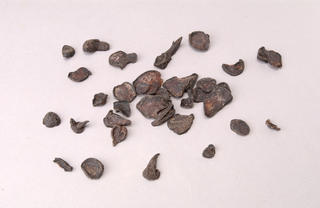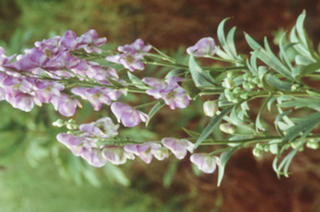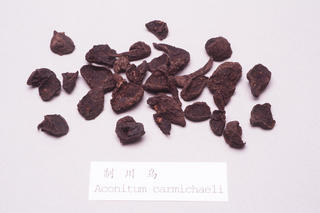Aconitum carmichaeli
Contents
Nomenclature
Other Names:
Historical Use of Aconitum carmichaeli
Aconitum carmichaeli in Traditional Chinese Medicine
Background
Chinese Name (pinyin): Zhichuanwu
Chinese Name :
Common Name :Prepared Common Monkshood Mother Root
Specific Name : Radix aconiti preparata
Scientific Name:
Collection : Procedure: Grade clean Radix Aconiti according to size, macerate in water until there is no dry core. Take them out, boil in water for 4 - 6 hours (or steam for 6 - 8 hours) until there is no white core in the relatively large and solid root` and the taste becomes slightly numb. After removal, dry in the air appropriately. Cut into slices and dry.
Description : Irregular or elongated triangular slices. Externally dark brown or yellowish brown with a greyish brown cambium ring. Texture light and fragile, fracture lustrous, odourless, taste slightly numb.
Identification : Complies with test (2) for Identification described under Radix Aconiti.Diester alkaloids: Reference preparation Weigh accurately 20 mg of aconitine CRS to a 10 ml volumetric flask. Add dehydrate ethanol to dissolve and dilute to volume.Preparation of calibration curve: Transfer accurately 0, 0.25, 0.50, 1.0, 2.0, 2.5 ml of the reference solution to 25 ml volumetric flask respetively and dehydrate ethanol to 2.5 ml, add accurately 1.5ml of alkaline hydroxylamine hydrochloride TS respectively and mix well. Warm on a water bath at 60 - 65ºC for 10 minutes and allow to cool. Add 13 ml of ferric perchlorate TS, mix well and stand for 5 minutes. Then add accurately 8 ml of perhloric acid TS. Dilute with ferric perchlorate TS to volume and mix well. Allow to stand for 15 minutes. Caary out the method for spectrophotometry (Appendix V B), using the first solution as the blank. Measure the absorbance at 520 nm and prepare the calibration curve with the absorbance as ordinate and the concentration as abscissa.Procedure: Weigh accurately 10g of the coarse powder to a stoppered conical flask, add 50 ml of ether and 4 ml of ammonia TS, stopper, shake thoroughly, allow to stand over night and filter. The drug residue is shaken with 50 ml of ether for 1 hour and filter. Wash the residue with 3 - 4 quantities, each of 15 ml of ether and filter. Combine the filtrate and washings and evaporate to dryness at a lower temperature. Dissolve the residue in 2 ml of chloroform and transfer to a separator. Wash the container with several quantities of 3 ml of chloroform and transfer the washings to the separator. Extract with 3 quantities of 5 ml of sulfuric acid (0.05 mol/L). Wash the acid solution with the same 10 ml of chloroform, successively combine the acid solution, adjust to pH 9 with ammonia TS and extract with quantities, each of 10 ml of chloroform, wash the chloroform solution with the same 20 ml of water successively. Combine the chloroform solution, evaporate to dryness to at a lower temperature. Dissolve the residue in a quantity of dehydrate ethanol, transfer the solution to a 5 ml volumetric flask, wash the container several times with dehydrate ethanol, combine the washings to the volumetric flask, dilute with dehydrated ethanol to volume and mix well. Transfer accurately 2.5ml of each of the above solution and dehydrate ethanol used as blank solution separately to 25 ml volumetric flask. Measure the absorbance as described under calibration curve preparation, beginning at the words "add accurately 1.5 ml of alkaline hydroxylamine hydrochloride TS. Read and calculate the weight (µg) of diester alkaloids in the test solution from calibration curve. It contains not more than 0.15% of diesteralkaloids, calculated as aconitine (C34H47NO4) on the dried basis.Assay: Weigh accurately 10g of the powder and carry out the method described under procedure of Diester alkaloids using a mixture of ether chloroform (3:1) instead of ether beginning at the words "add 50 ml of ether ™˜˜˜˜" to " combine the filtrate and washings, evaporate to dryness at a lower temperature". Dissolve the residue in 5 ml of the mixture of ether chloroform (3:1), evaporate to dryness. Dissolve the residue again in 5 ml of ethanol, add 15 ml of sulfuric acid (0.01 mol/L) VS, accurately measured, 15 ml of water and 3 drops of methyl red IS and titrate with wit6h sodium hydroxide (0.02 mol/L) VS until a yellow color is produced. Each ml of sulfuric acid (0.01 mol/L) VS in equivalent to 12.9 mg of C34H47NO11. It contains not less than 0.20% 0f alkaloids calculated as Aconitine (C34H47NO11).
Processing :
Action : To relieve rheumatic conditions and alleviate pain by warming the channels.
Indication : menstrual disorders, amenorrhea, dysmenorrhea, abdominal pain with mass formation, pricking pain in the chest and costal regions, swelling and pain due to traumatic injury, headache, rheumatic arthalgia
Precautions : Used with caution in pregnancy. Incompatible with Bulbus Fritillariae, Rhizoma Pinelliae, Rhizoma Bletillae, Radix Ampelopsis, Radix Trichosenthis, Fructus Trichosanthis and Corus Rhinoceri.
Dosage : 1.5 to 3 g, to be decocted for a long time before other ingredients.
Storage : Preserve in a ventilated dry place.
Synonymns for Aconitum carmichaeli
Patent Medicines and Medicines with Multiple Ingredients that include Aconitum carmichaeli
Pharmaceutical Information
Chemical Constituents
Evidence or the Use of Aconitum carmichaeli in the Treatment of Epilepesy
Basic Science
Animal Studies
Cohort, Case-Control and Non-Randomized Trials
Randomized Controlled Trials
Meta-Analysis
1st Five Results: pubmed search
Wen Zhang, Menglei Ding, Yaru Feng, Shuhui Cai, Zichen Luo, Jinjun Shan, Liuqing Di
Modulation of cellular metabolism and alleviation of bacterial dysbiosis by Aconiti Lateralis Radix Praeparata in non-small cell lung cancer treatment.
Phytomedicine: 2024, 126;155099
[PubMed:38412665]
[WorldCat.org]
[DOI]
(I p)
Min Chen, Shanjiao Huang, Shuoyun Weng, Junting Weng, Rongjie Guo, Bingbing Shi, Danjuan Liu
Songorine ameliorates LPS-induced sepsis cardiomyopathy by Wnt/β-catenin signaling pathway-mediated mitochondrial biosynthesis.
Naunyn Schmiedebergs Arch Pharmacol: 2023;
[PubMed:38133657]
[WorldCat.org]
[DOI]
(I a)
Jiao Yao, Cong Chen, Yang Sun, Yuting Lin, Zhifeng Tian, Xinya Liu, Huiqin Wang, Junpeng Long, Qian Yan, Meiyu Lin, Qidi Ai, Yan Gao, Naihong Chen, Yantao Yang, Songwei Yang
Higenamine exerts antidepressant effect by improving the astrocytic gap junctions and inflammatory response.
J Affect Disord: 2024, 348;107-115
[PubMed:38101523]
[WorldCat.org]
[DOI]
(I p)
Zejun Liu, Xiaoli Li, Qi Luo, Hong Pan, Fuguo Shi
Structural feature-based strategy for the identification of diterpene alkaloids in Aconitum carmichaeli Debeaux.
Fitoterapia: 2024, 172;105761
[PubMed:38036079]
[WorldCat.org]
[DOI]
(I p)
Gelin Xiang, Sa Guo, Jing Qin, Huimin Gao, Yi Zhang, Shaohui Wang
Comprehensive insight into the pharmacology, pharmacokinetics, toxicity, detoxification and extraction of hypaconitine from Aconitum plants.
J Ethnopharmacol: 2024, 321;117505
[PubMed:38016573]
[WorldCat.org]
[DOI]
(I p)



